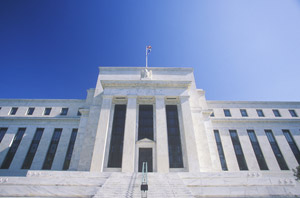The Fed meeting today (Wednesday) continued to fuel discussions about when the U.S. Federal Reserve is going to finally raise interest rates.
After all, labor market conditions had cleared up - at least by the Fed's metrics - ahead of today's conclusion of the two-day Federal Open Market Committee (FOMC) meeting. The economy added 295,000 jobs in February, and the unemployment rate sits at an impressive 5.5%.
But the other side of the Fed's dual mandate paints a grimmer picture...
 The Consumer Price Index has fallen three straight months - in November 2014 by 0.28%, in December 2014 by 0.33%, and in January 2014 by 0.68%. The Producer Price Index has fallen eight straight months.
The Consumer Price Index has fallen three straight months - in November 2014 by 0.28%, in December 2014 by 0.33%, and in January 2014 by 0.68%. The Producer Price Index has fallen eight straight months.
And economic indicators seem to suggest we're not pulling away from these deflationary numbers anytime soon. The U.S. Dollar trade-weighted index is at its highest levels in 11 years. It's up 6% on the year alone, and 15% in the last 12 months.
Dollar strength seems to have no downside right now. Every major currency is falling against the greenback.
The six currencies making up the U.S. dollar index are all in countries where interest rates are extremely low. The highest rates can be found in the U.K., at 0.5%. Three other currencies, the euro, the yen, and the Canadian dollar have more or less a zero interest rate policy (ZIRP). The remaining two, the Swedish krona and the Swiss franc, have negative interest rates.
Rising interest rates will only add to these deflationary pressures.
The real question is how to prepare for this environment...
Here's how deflation, and further pressures from rising interest rates, will affect investments over several asset classes.
Currencies to Watch After Fed Meeting Today
As mentioned earlier, the dollar is climbing. While every major currency has been falling, the most dramatic currency moves are coming from the Eurozone and Japan.
The European Central Bank just last week fired up the printing presses for an 18-month, 1.2 trillion euro bond-buying program. And in October 2014 the Bank of Japan accelerated its already aggressive program of asset purchases at a pace of as much as 80 trillion yen a year.
In both cases, there's a direct opportunity to profit off these quantitative easing measures. They are going to stoke inflation in those economies and weaken currencies. Dollar parity is likely to come as early as 2016. That means there's still a chance to get in on at least 6.3% gains through the ProShares Short Euro (NYSE Arca: EUFX). This is an exchange-traded fund that shorts the euro.
It's the same case with the yen. The current USD/JPY conversion rate is 120.85. Money Morning Chief Investment Strategist Keith Fitz-Gerald said that could shoot up to 200 in the next two years as BOJ QE and weak domestic demand ravage the yen. You can do that with the ProShares UltraShort Yen (NYSE Arca: YCS).
Money Morning members - keep reading to see what to expect from stocks and bonds after the Fed meeting today...
Stocks to Watch After Fed Meeting Today
A stronger dollar is a mixed bag for stocks.
On one hand, it will hit companies that do international business and handle sales globally. They'll sell fewer goods abroad as the dollar strengthens.
But at the same time, it can be good for some domestic companies who do business primarily in the United States. They can import from abroad at lower prices and then sell their products with a stronger dollar.
That's why Money Morning Capital Wave Strategist Shah Gilani recommends Dominion Resources Inc. (NYSE: D).
"It's a play that's all-American. The company is a gas producer, a gas manufacturer, [it's in] transmission lines, electricity transmission - so it's in that domestic business," Gilani said.
There is a caveat, however. The stronger dollar doesn't necessarily mean you should get out of large multinational companies altogether. A global presence is typically a good thing for a company. While currency headwinds will hit these companies in overseas business, for the strong multinationals this should be a very minor issue.
Take a company like Apple Inc. (Nasdaq: AAPL). It has $178 billion in cash sitting on its books. Does anyone really think Apple is going to be devastated by currency headwinds? It's not likely.
The bottom line here is to use this opportunity to pick up on stocks with strong domestic business because they stand to benefit. But don't abandon the healthier multinationals just because of currency concerns.
Bond Investing After the Fed Meeting
[epom key="ddec3ef33420ef7c9964a4695c349764" redirect="" sourceid="" imported="false"]
Times of deflation are good times for bond investing.
That is if you're buying and holding bonds for the long-term, just looking for interest rate income. That's because real interest rates are defined as nominal interest rates minus inflation. In deflation, you're receiving interest payments in the form of stronger dollars. In essence, you're collecting income that is higher than the actual expressed interest rate.
If you're looking for a good long-term, buy-and-hold bond fund that brings in a high yield, you may want to try the PIMCO Strategic Income Fund Inc. (NYSE: RCS), which yields an impressive 8.6%.
The Fed could raise interest rates earlier than expected...it's those very fears that have been dragging down the markets over the last couple weeks. Money Morning Chief Investment Strategist Keith Fitz-Gerald says, "Bring it on!" The Fed concerns have triggered dips and provided massive profit opportunities...


